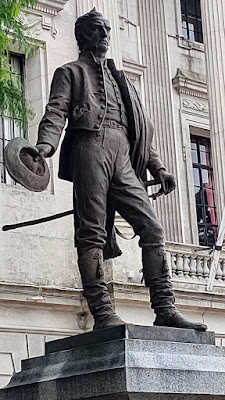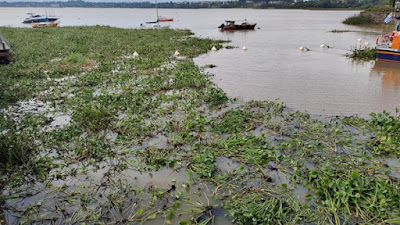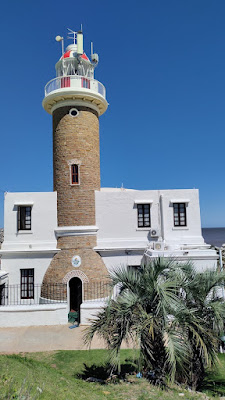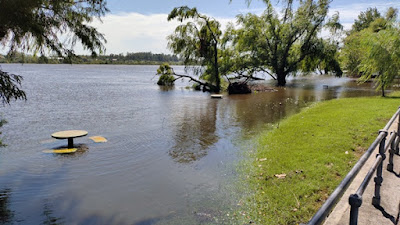The Route 3 north to Buenos Aires is a long, boring drive for the most part. We detoured at Viedma to go see the burrowing parrots that live in these holes in the cliffs above the beach. They come and go at sunrise (above) and sunset, so it's hard to get good photos, but they are big green parrots and squawk up a storm when they are around.
A small group of parrots swoop up and down over the edge of the cliff where we were parked.These holes in the dirt/clay/sand cliffs house hundreds or thousands of parrots. They hunker back into the shadows when they land so you can hear them but can't always see them.
Many miles away we were still seeing flocks of the parrots in some areas. Their long tails, blunt head shapes and the telltale squawks help identify them as the same kind of green parrots.
Huge fields of some green crop had us stumped as to what it was, so we stopped along an unfenced area and Jason braved the soggy ground and mosquitos to grab a bit of it. It's soybeans, a big crop here in Argentina, along with corn.
We stopped in Mercedes, Uruguay after crossing the border bridge at Fray Bentos. The recent rains had wreaked havoc on their computer system and after 45 minutes, they finally gave up and had to hand write our new Temporary Import Permit for Uruguay. All the tourist attractions here in Mercedes had been closed due to damage from the high winds and rains from a few days before. Still, the church dome in the morning sunlight was a pretty sight from our van.
Flooded fields were everywhere! The rain washed the loose weeds into the fence wires that were at/under the water level.
The river is supposed to be to the right of those trees, but it has overflowed and is now running through the neighboring fields as well. Folks here said this is definitely not normal, especially at this time of the year.
At Camelo, we stopped to look at the raging river next to the town. This was a potential spot for us to stop, but it looked too uncertain for us. Huge islands of green plants, like water lilies, floated down on the current.
A local family kept a few rheas/nandus behind a fence. This is about as close as we'd ever gotten to see them when we were standing still. They're like smaller ostriches or emus, with big plumes for feathers. They are very skittish in the wild.
This farmer was driving his horse cart down the shoulder of the main road. Horses are still used a lot here. We see them staked out along the highway feeding on the grass on the side of the road.
We spent a couple of nights in the old town of Colonia. It was an important railroad town on the river.
The railroad roundhouse is now a government tourist agency office. Old bricks and new glass make a pleasing combo.
Water around the circular train turnstile was a rusty orange. They used to swivel the train cars around here.
In Montevideo, we came across this statue of a man in front of a government building. The intricate details of the buttons and wrinkles were pretty impressive, but the yellow and green bird perched on top of his head didn't move when I got close enough to take the photo.
A tile map of the La Plata River that separates Buenos Aires, Argentina and Montevideo, Uruguay. Old and decorative.
The old historic buildings along the river in Uurguay are falling into disrepair. They are crumbling, the wood is rotting, and the walls are being attacked by vandals and marked up by graffitti. Sad, but they will need a lot of work if they are to be saved and restored. This 1866 Wharf of Colonia building is in the historic district that is now a UNESCO site.
This mass of water plants had gathered in front of the building above. The large mats of greenery choked many areas along the waterfront after the recent rains.
Karen at an old fort tower along the waterfront in Colonia del Sacramento in Uruguay.
This statue in Colonia del Sacramento has a man holding a torch over his head. Unusual.....
Old cannons line the sidewalk with the lighthouse in the background.
The lighthouse is still surrounded by old brick and stone walls. The colorful building in the foreground used to be the Convent of San Francisco, and dates from the 17th century.
Jason examining the wares of a street vendor in Colonia del Sacramento, Uruguay. The designs on the clay vessels made them look like they were carved out of wood.
Jason enjoying the afternoon at the park where we stayed. This location was the only legal spot for motorhomes to park overnight in the area. We were the only ones there. It's across the street from the beach, so it was a great location.
The two old water tanks in Colonia where the trains used to fill with water for their steam. They are at the water's edge by the train roundhouse next to the modern ferry building that takes people and vehicles across the river to Buenos Aires.
Lots of old vehicles in this area and this one has been turned into a greenery display on the street.
The old car that contains the greenery above. It just sits on the street.
This old truck is now a mobile beer bar. The board sticking out the back has several beer taps on it to connect to kegs they would load into the bed of the truck. Party on in Colonia!
The Portuguese established Colonia del Sacramento in 1680. It was fought over by the Spanish and Portuguese and changed hands back and forth with the wars and treaties. It is considered an historic fusion of the two styles of architecture with the neo-Classical joining in. Its historic quarter is now a UNESCO World Heritage Site. Jason walking in front of an old stone building near the waterfront.
Karen in front of the lighthouse with its 17th century walls surrounding it.
Jason crossing a lawn in the historic area to look at the tile map and stone walls of the remains of buildings.
The ceramic tile map of old Colonia del Sacramento.
Street sign on the ancient 17th century cobblestone way. Known as the "Street of Sighs", it was where sailors' wives used to come to watch for the return of their husbands and ships.
This view of the Street of Sighs doesn't give you the same feeling as walking along the old cobblstones and rocks that form it. The street has a slight indent in the center and water over the centuries has washed away much of the sediment from between the rocks. You must watch where you walk or can easily turn an ankle on this rugged rock road.
This old city was walled for protection and this is the City Gate, complete with a wooden drawbridge. Jason tugs on the chain, but it doesn't raise the gate.
From our campsite, we watched this man walking his racehorse around the area for exercise.
A modern skyscraper in Montevideo, Uruguay
French Colonial architecture is one of the draws of the city of Montevideo. This was taken through the windshield as we drove along the waterfront.
We parked for the night in a lot near the old lighthouse. Much of the space was taken up by this circus set up in the parking area.
The old lighthouse at Punta Brava was closed and the entire area behind the circus was under construction, limiting the places for people to park. There is supposedly a restaurant in the lighthouse, also closed, but this is next to a garbage depot and water treatment area so the air had a terrible stench to it! I couldn't imagine eating while breathing that stinky air!
The sign at the lighthouse at Punta Brava.
We walked to the fancy new mall at Punta Carretas. We wanted to try the national dish, Chivito--a huge layered dish of beef, ham, cheese, and egg on a bun. Or in our case, on a layer of french fries as we ordered a plate for two. It had lettuce, tomato, and green olives on the heap as well. Can't say it was one of our favorite dishes, but we had to try it.
Jason at the giant high-heeled shoe at the entrance to the mall.
The entrance to the Punta Carretas mall. Until a few years ago, this used to be a prison. Now it's a mall with all the fancy brands you'd find in a top mall in the US.
This black metal slab just outside the mall entrance has all the prisoners' names engraved in it. This area is now a wealthy residential area and very popular.
While reviewing the metal slab above, we heard a commotion between these two men. A taxi driver wielding a tire iron and a vagrant were arguing about something and seemed about to come to blows. The vagrant retreated to the arched gate of the mall area and reached down, grabbed a loose sidewalk tile, slammed it down to break it into pieces and carried a chunk in each hand as he advanced once again to confront the taxi driver. Eventually, the taxi drove away before an actual fight ensued. Entertainment at the mall in Montevideo, Uruguay.
This tiny abode was parked in front of us in the lighthouse/circus parking lot. I thought it was a small food cart, but Jason thinks the guy was living in it!
The rounded humps of the towers on all four corners and the center of the building in the background drew my eye. The building used to be the royal palace here in Montevideo. The glass building in front is not part of the old French palace behind it.
Typical street scene in Montevideo, along a pedestrian walkway.
The pedestrian walkway had these suns set into the bricks, much like the stars set into the sidewalks in Hollywood. This one is for The Rolling Stones. The sun symbol is the symbol of Uruguay.
Lots and lots of statues and monuments in this city, honoring people of the past. We knew none of the names in Uruguayan history.
These policemen and their horses hung out in the shade of this big tree near the waterfront boulevard known as the Rambla
We drove to Punta del Este, the East Point, of Uruguay, along the water. The architecture of the cities here is interesting and these huge old historic buildings present a great facade in the traffic of the modern city.
Jason wanted to see the 'Fingers' at Punta del Este. These huge digits look like a giant hand coming out of the ground on the beach.
Jason next to the giant fingers in Uruguay. The Atlantic Ocean is there on the left.
The giant fingers and the highrise skyline of Punta del Este, Uruguay, on the southeast peninsula. Some call this city the Monaco of South America.
Across the street is a gallery of artistic installations and sculptures along the waterfront, thanks to the Pablo Atchugarry Foundation. Jason inspects one of the few that we found of any interest.
We walked the entire length of the city to the marina by the lighthouse. The fishermen cleaned their catches on these tables, but the dog just wanted to snooze. He wasn't bothered by the sea lions that lingered in the water at the edge of the sidewalk waiting for offcasts from the fishermen.
A pretty blue church with the Punta del Este lighthouse in the distance. It was a very long walk across town.
We came back to the hand and fingers to get our van, then drove back to the marina to get showers.
Pretty pink church building in Punta del Este. Looks like it should be on a post card.
We headed back towards Argentina, hoping the roads and bridges weren't going to be washed out. This riverfront park in Mercedes was still under water from the previous week's deluges. We'd been forced to move at 10PM one night when biblical rains caused the streets and rivers to flood all around us. We had to drive through about a foot of water in the dark, in driving rain in an unfamiliar town where we'd found the campground closed and the bridge next to it washed away. We had to dodge the manhole covers that were spouting pressurized water up through their grates, making them look like white waffles floating above the street. It went from dry to flooded in less than two hours!
One of the few dry places we found to park was at a Shell station. We snagged a spot in the corner of their lot and found this billy goat, a llama, a sheep and some nandus/rheas in a field on the other side of the fence. The goats liked to climb on the trash and tiles in the corner of the fenced area. At night, we saw rats jumping out of an old pipe nearby.
The main highway drove through this waterlogged area. That lake of water isn't supposed to be there!! The rains here have flooded everything around, including this land that should be pasture for cattle.
Back in Argentina, we went to Tigre, a riverfront town that we'd heard was nice. Looking at the area in satellite view, you can see they've made intricate designs in the water and greenery here. The river traffic includes these log boats that move logs farther downriver where they can be offloaded to ships or trucks to be sent to a lumber yard. There is no freeboard on these flat-bottomed boats, so the logs on the bottom obviously get wet during transport. They couldn't possibly move very far if there if any wind or chop on the water.
Karen selfie along the riverfront at Tigre. So much green after the dry brown of the Argentina steppe and pampa!Jason at the big letters of Tigre. Tourist boats ply the river and take folks along the different channels to see the sights of the area.
The waterfront is a tourist outdoor shopping area. This store specialized in the things needed for drinking yerba mate, the national drink in these South American countries. The cups are called 'gourds' and the filtering straws are called 'bombillas'. None of them are cheap; yet, you rarely see locals without a thermos of hot water and a gourd of mate that they sip from all day long. Mate reminds me of really strong green tea. It's supposed to be much better for you than coffee and contains caffeine that energizes its drinkers.
Back to Buenos Aires. With so much uncertainty swirling around our being able to get our van shipped back to the USA, we decided we'd see about getting our passports renewed in Buenos Aires. Most foreign countries require at least 6 months remaining before the expiration of a passport and we weren't going to have that much time left after the van got dropped off for shipping. If there was any problem, we'd be stuck in Argentina and not able to go anywhere except back home to the USA. The Embassy is downtown and we found a park we could stay in overnight within short walking distance.
This statue was in the center of a large roundabout in Buenos Aires near the park.
This monument is one of the most famous in the city and we could see it from our parking location. It's the Magna Carta and the Four Argentine Regions, but most know it as the Monument to the Spaniards. It dates from 1927 and the US Embassy is just across the street from here.
Green parrots and pigeons vie for crumbs in a parking lot. Some of the big roads near the waterfront parks have been blocked off to vehicle traffic and are now just for walkers and bikers and exercisers, GoogleMaps doesn't seem to know this yet, so driving in the city takes on new challenges.
The blue bunny comes out as Easter approaches the waterfront of Buenos Aires.
Another view of the Monument to the Spaniards. It's really quite detailed, but is in the center of another busy roundabout so we couldn't get close for long to admire it. According to Wikipedia, the Spanish ship carrying the bronze pieces sunk in 1916 along the coast of Brazil and a replica had to be ordered, finished in 1918. It was finally inaugurated in May 1927, and it's still in top form!
The Obelisk in Buenos Aires is just like the one in Washington, D,C. It's 67 meters tall and is the spot where the Argentine flag was first raised in the city. It was built to mark the 400th year of the city's first foundation.
This classic French Colonial building is the Cultural Center Kirchner, or CCK. The view from its rooftop balcony is said to be wonderful. We visited one day, but the 6 floors were mostly empty and you couldn't go to the overlook area. Pretty boring, really. So much empty space in such a big building.

These old wooden cranes still stand along the river canal at the edge of the city.Large sailing vessels still get up into the river as well.
Easter week turned into a 6-day holiday because the Tuesday after Easter was Malvinas Day. They still insist the Falkland Islands belong to Argentina and are called the Malvinas. The rest of the world knows them as the UK's Falkland Islands. The war in 1982-3 is still a sore subject here and we avoid the topic with locals. Anyway, we headed to Punta Lara, down the coast by La Plata to spend the days at a beach park. Everything in the city was closed down so there wasn't much sense in staying in town. This is the beach along the mile-long beachfront park.
A group of old Chevy Chevelles gathered in the park one afternoon. I always liked these muscle cars.This monument is one of the most famous in the city and we could see it from our parking location. It's the Magna Carta and the Four Argentine Regions, but most know it as the Monument to the Spaniards. It dates from 1927 and the US Embassy is just across the street from here.
Green parrots and pigeons vie for crumbs in a parking lot. Some of the big roads near the waterfront parks have been blocked off to vehicle traffic and are now just for walkers and bikers and exercisers, GoogleMaps doesn't seem to know this yet, so driving in the city takes on new challenges.
The blue bunny comes out as Easter approaches the waterfront of Buenos Aires.
Another view of the Monument to the Spaniards. It's really quite detailed, but is in the center of another busy roundabout so we couldn't get close for long to admire it. According to Wikipedia, the Spanish ship carrying the bronze pieces sunk in 1916 along the coast of Brazil and a replica had to be ordered, finished in 1918. It was finally inaugurated in May 1927, and it's still in top form!
The Obelisk in Buenos Aires is just like the one in Washington, D,C. It's 67 meters tall and is the spot where the Argentine flag was first raised in the city. It was built to mark the 400th year of the city's first foundation.
This classic French Colonial building is the Cultural Center Kirchner, or CCK. The view from its rooftop balcony is said to be wonderful. We visited one day, but the 6 floors were mostly empty and you couldn't go to the overlook area. Pretty boring, really. So much empty space in such a big building.
The only interesting exhibit was the room where Eva Peron had her salon. In the corner was a huge pile of letters to her that had been shaped into a Christmas tree of envelopes.
Toys Eva Peron gathered for her children or to give away. This room was left just as it was when she used it.

These old wooden cranes still stand along the river canal at the edge of the city.
Easter week turned into a 6-day holiday because the Tuesday after Easter was Malvinas Day. They still insist the Falkland Islands belong to Argentina and are called the Malvinas. The rest of the world knows them as the UK's Falkland Islands. The war in 1982-3 is still a sore subject here and we avoid the topic with locals. Anyway, we headed to Punta Lara, down the coast by La Plata to spend the days at a beach park. Everything in the city was closed down so there wasn't much sense in staying in town. This is the beach along the mile-long beachfront park.
Park of the Women of Argentina, a large open grassy area near where we parked in the city of Buenos Aires before and after the Easter holidays.
Old grain silos have been turned into art along the waterfront. Each tower has one work of inspiration on it. The backs are still bare abandoned concrete faces.
We walked the distance to our shipping agent's office. Along the way Jason encountered this cartoon character statue along a walkway.
Karen with another cartoon statue a bit farther along the road.
Another statue/monument in a plaza in Buenos Aires.






















































































